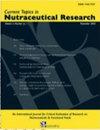芍药苷对实验性青光眼视网膜神经节细胞的保护作用
IF 0.4
4区 医学
Q4 NUTRITION & DIETETICS
引用次数: 0
摘要
青光眼是一种进行性神经退行性眼病,其特征是眼压升高和视网膜神经节细胞丧失,导致部分或全部视力丧失。我们研究了芍药苷是否能降低青光眼诱导大鼠的眼压并提高视网膜神经节细胞的存活率。通过末端脱氧核苷酸转移酶dUTP缺口末端标记法和荧光金标记法测定,在边缘静脉注射高渗盐水溶液引起眼压升高的大鼠中,口服芍药苷可显著降低眼压升高并显著防止视网膜神经节细胞损失。芍药苷可有效降低转化生长因子β蛋白的表达。此外,视神经头和视网膜神经节细胞层中细胞外基质成分基质金属蛋白酶9(金属蛋白酶1的组织抑制剂)——层粘连蛋白、I型胶原和IV型胶原的表达也有效减少。芍药苷显著上调Janus激酶-2/信号转导子和转录激活蛋白-3信号传导的激活,这在视网膜神经节细胞的存活中起着至关重要的作用。这些结果表明,芍药苷通过调节转化生长因子β2信号传导和Janus激酶2/信号转导子和转录激活蛋白-3信号传导,降低眼压、视网膜神经节细胞损失和细胞外基质变化,具有保护作用。目前的研究表明,芍药苷可能是一种很有前途的治疗青光眼的药物。本文章由计算机程序翻译,如有差异,请以英文原文为准。
Paeoniflorin Protects Retinal Ganglion Cells in Experimental Glaucoma
Glaucoma is a progressive neurodegenerative eye disease characterized by raised intraocular pressure and a loss of retinal ganglion cells, resulting in partial or total vision loss. We have investigated whether paeoniflorin could reduce intraocular pressure and improve retinal ganglion cell survival in glaucoma-induced rats. In rats with raised intraocular pressure induced by injecting hypertonic saline solution into the limbal veins, oral paeoniflorin markedly brought down the elevated intraocular pressure and significantly prevented retinal ganglion cell loss, as determined by the terminal deoxynucleotidyl transferase dUTP nick end labeling assay and Fluoro-Gold labeling. The expression of the transforming growth factor β protein was effectively diminished by paeoniflorin administration. Also, the expression of extracellular matrix components matrix metalloproteinase 9 a tissue inhibitor of metalloproteinase 1—laminin, collagen I, and collagen IV in the optic nerve head and retinal ganglion cell layer were effectively diminished. Paeoniflorin substantially upregulated the activation of Janus kinase-2/signal transducer and activator of transcription proteins-3 signaling, which plays a crucial role in retinal ganglion cell survival. These results illustrate a protective effect of paeoniflorin through reduction of intraocular pressure, retinal ganglion cell loss, and changes in the extracellular matrix by regulating transforming growth factor β2 signaling and Janus kinase-2/signal transducer and activator of transcription protein-3 signaling. The present work demonstrates that paeoniflorin may be a promising therapeutic agent for glaucoma.
求助全文
通过发布文献求助,成功后即可免费获取论文全文。
去求助
来源期刊
CiteScore
1.10
自引率
0.00%
发文量
36
审稿时长
>12 weeks
期刊介绍:
Current Topics in Nutraceutical Research is an international, interdisciplinary broad-based peer reviewed scientific journal for critical evaluation of research on chemistry, biology and therapeutic applications of nutraceuticals and functional foods. The major goal of this journal is to provide peer reviewed unbiased scientific data to the decision makers in the nutraceutical and food industry to help make informed choices about development of new products.
To this end, the journal will publish two types of review articles. First, a review of preclinical research data coming largely from animal, cell culture and other experimental models. Such data will provide basis for future product development and/or human research initiatives. Second, a critical evaluation of current human experimental data to help market and deliver the product for medically proven use. This journal will also serve as a forum for nutritionists, internists, neurologists, psychiatrists, and all those interested in preventive medicine.
The common denominator of all of the topic to be covered by the journal must include nutraceuticals and/functional food. The following is an example of some specific areas that may be of interest to the journal. i) Role of vitamins, minerals, antioxidants and phytonutrients on cardiovascular health, cancer, diabetes, ocular health, mental health, men’s health, women’s health, infant nutrition, ii) Role of herbals on human health, iii) Dietary supplements and sleep, iv) Components of diet that may have beneficial effect on human health, v) regulation of apoptosis and cell viability, vi) Isolation and characterization of bioactive components from functional foods, vii) Nutritional genomics, and viii) Nutritional proteomics.

 求助内容:
求助内容: 应助结果提醒方式:
应助结果提醒方式:


